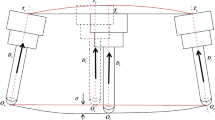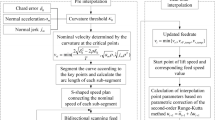Abstract
In industries such as electronics 3C, medical, aviation, and energy, multi-axis machining machines are an important element of modern production systems, especially for post-processing, which necessitates the safe operation of control equipment. Some controller and software for five-axis simultaneous machining only interpolate equidistantly between cutter location (CL) points and do not support post-processing using a rotation tool center point (RTCP) so the machining path of the tool has manufacturing errors (overcutting or undercutting) and the workpiece fails to be machined to the correct size. Depending on the maximum allowable error (δMax), this study uses rapid unequal interval sub-point interpolation to perform sub-point interpolation on the original path of the five-axis machining machine, and the sub-point values are output in the computer numerical control (CNC) machining program in C# programming language. The tool tip is then moved to the desired machining position. Finally, an example involving helical milling of a curved surface is used to verify the feasibility of the rapid unequal interval interpolation method (RUIIM). The experimental results show that rapid unequal interval sub-point interpolation gives a more accurate original path that is generated in the CAM and a faster processing speed for the entire controller so the operation speed is increased.



























Similar content being viewed by others
Data availability
All necessary data are shown in the figures and tables within the document. The raw data can be made available upon request.
References
Sakamoto S, Inasaki I (1993) Analysis of generating motion for five-axis machining centers. The Japan Society of Mechanical Engineers 59(561):1553–1559
Lin AC, Lin TK, Lin TD (2014) Derivinggeneric transformation matrices for multi-axis milling machine. International Journal of Mechanical, Aerospace, Industrial, Mechatronic and Manufacturing Engineering 8(7):2625–2629
Lee RS, She CH (1997) Developing a postprocessor for three types of five-axis machine tools. Int J Adv Manuf Technol 13:658–665
Takeuchi Y, Watanabe T (1992) Generation of 5-axis control collision-free tool path and postprocessing for NC data. CIRP Ann 41:539–542
Jung YH, Lee DW, Kim JS, Mok HS (2002) NC post-processor for 5-axis milling machine of table-rotating or tilting type. J Mater Process Technol 130–131:641–646
Vavruska P (2016) Interpolation of toolpath by a postprocessor for increased accuracy in multi-axis machining. Procedia CIRP 46:336–339
Lai YL, Liao CC, Chao ZG (2018) Inverse kinematics for a novel hybrid parallel–serial five-axis machine tool. Robotics and Computer-Integrated Manufacturing 50:63–79
Lin TD, Lin AC (2014) Using interpolation points to rectify cutter paths of five-axis machining. Appl Mech Mater 275–277:2625–2629
Yu DY, Ding Z (2019) Post-processing algorithm of a five-axis machine tool with dual rotary tables based on the TCS method. The International Journal of Advanced Manufacturing Technology 102:3937–3944
Funding
The authors appreciate the financial support of the Ministry of Science and Technology of the Republic of China (MOST 108–2221-E-262–002-MY2 and MOST 110–2622-E-262–004).
Author information
Authors and Affiliations
Contributions
W-CC: conceptualization, conduct experimental process, data curation, characterization, validation, analysis, and writing—original draft. T-KL: advisor and methodology. H-MT: conduct experimental process and data curation. C-CT: conceptualization, project administration, funding acquisition, revised grammar, and writing—review and editing draft. All authors have read and agreed to the published version of the manuscript.
Corresponding author
Ethics declarations
Ethics approval
Not applicable.
Consent to participate
Not applicable.
Consent for publication
Not applicable.
Conflict of interest
The authors declare no competing interests.
Additional information
Publisher's note
Springer Nature remains neutral with regard to jurisdictional claims in published maps and institutional affiliations.
Rights and permissions
Springer Nature or its licensor (e.g. a society or other partner) holds exclusive rights to this article under a publishing agreement with the author(s) or other rightsholder(s); author self-archiving of the accepted manuscript version of this article is solely governed by the terms of such publishing agreement and applicable law.
About this article
Cite this article
Chen, WC., Lin, TK., Teng, HM. et al. The use of the rapid unequal interval interpolation method (RUIIM) for a non-RTCP NC program and five-axis machining. Int J Adv Manuf Technol 124, 2701–2717 (2023). https://doi.org/10.1007/s00170-022-10568-7
Received:
Accepted:
Published:
Issue Date:
DOI: https://doi.org/10.1007/s00170-022-10568-7




